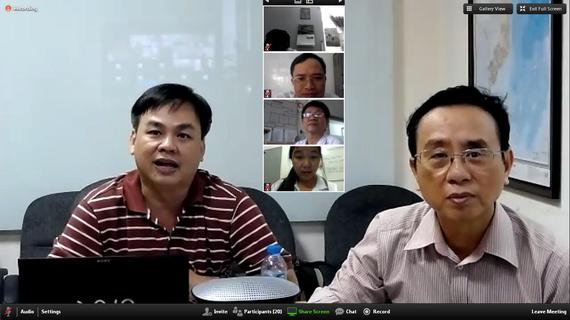
HIV specialists in Vietnam use video conferencing to train local health workers. (Photo courtesy of HAIVN)
By Will Greene
A shortage of skilled health workers is an acute and ongoing problem in many emerging markets. Weak medical education systems bear a major part of the blame. But a big opportunity for rapid progress has emerged as online medical education becomes increasingly common. Doctors and nurses in even the poorest countries can now get much better training.
Medical education in emerging markets typically suffers from two problems. First, medical universities and residency programs rarely have enough qualified instructors, and sometimes lack access to modern curricula and equipment. Second, weak or nonexistent continuing medical education (CME) programs prevent health workers from later keeping their skills sharp.
The global healthcare talent gap is particularly acute in the world's poorest countries. The World Health Organization estimates that the world needs more than 7 million additional skilled health professionals, with shortages at crisis proportions in many parts of South Asia, Southeast Asia, and Africa.
The WHO predicts the crisis will only worsen in coming years, but that may underestimate the potential impact of new e-learning technologies to enable low-cost medical training at scale. Many universities, government health agencies, NGOs, private companies, and doctors around the world are embracing such technologies, sometimes with promising results.
Medical education typically begins with university coursework, and many medical schools now use e-learning tools like webcasts and online study aids to broaden enrollment and improve educational outcomes. Some are working to adopt and apply these tools in emerging markets, though often-onerous data charges, patchy connections, lack of technological competency, and other challenges can limit their efficacy.
The University of Washington's Department of Global Health is a leader in the use of distance learning technologies for low-resource settings. Through an initiative called eDGH, it runs e-learning programs in more than 30 countries. Since 2007, when it opened two small program sites in Kenya and Haiti, it's delivered classes to students in many of the world's poorest places. Its flagship course on Clinical Management of HIV now reaches over 1,000 students globally each year.
"Training qualified health workers requires a lot more than just slapping some course materials online and calling it a day," says Michael Chung, eDGH's co-director. In a typical program, students watch lectures and submit homework virtually, but still attend regular local classes for discussions with peers and professors. This approach, often called "blended learning," helps reduce program costs without compromising quality standards.
E-learning technologies can also streamline and scale up residency programs. In radiology, for instance, a growing number of hospitals around the world now use software by Lifetrack Medical Systems, a digital healthcare startup that Techonomy profiled in November 2014. The software enables radiology residents to receive virtual training from qualified practitioners anywhere in the world -- a boon for places like Indonesia and Myanmar with acute radiologist shortages.
Even surgery can now be taught remotely with technologies that combine virtual reality with AI techniques to train both real time decision-making and psychomotor skills. Dr. Peter Haddawy, a Bangkok-based computer scientist who's developing these technologies, says they're actively being used for surgery students in Thailand. He believes they will be particularly valuable in emerging markets facing shortages of expert surgeons.
Irrespective of specialty, medical education must be a lifelong pursuit for all healthcare professionals, and in developed countries, regulators and professional associations typically require health workers to periodically participate in ongoing programs to keep their skills sharp. Many emerging countries lack such requirements, but online platforms are starting to fill this critical gap.
Some such platforms help by promoting professional mentoring. In Vietnam, for instance, a Harvard Medical School-affiliated NGO called HAIVN runs a video conferencing platform that connects HIV specialists in top Vietnamese hospitals with frontline community health workers. Inspired by Project ECHO, a University of New Mexico program that pioneered the use of video conferencing for remote training in healthcare, HAIVN now operates in more than 20 provinces in Vietnam.
FHI360 is another NGO using innovative online platforms to provide continuing medical education in emerging markets. Its USAID-funded Control and Prevention of Tuberculosis Project, which Techonomy highlighted in January, does this for health workers in Thailand and China with Qstream, a web and mobile application that supports workforce skill building. The app delivers informational content to distributed teams, drawing on principles from neuroscience and game mechanics to maximize uptake and retention.
In many places, health workers are taking CME into their own hands simply by going online to improve their knowledge and skills. In the Philippines, for example, a group of doctors founded an online community called HealthXPh that uses social media to mobilize discussion about healthcare topics. In neighboring Indonesia, more than three-quarters of doctors in major cities reported using the Internet regularly to build their knowledge and skills, according to a 2013 survey by Edelman Indonesia.
E-Learning and Global Public Health
To be sure, improving healthcare in emerging markets is about much more than just expanding the health workforce. Countries need tools to ensure that health workers, once trained, end up where they are most needed. Interventions for behavior change at the community level, such as campaigns to promote hand washing and basic hygiene, will also be indispensable. So will massive investments in public health infrastructure, stronger regulatory regimes, and R&D for new and improved treatments.
Yet health workers remain the frontline stewards of public health, and healthcare systems cannot function without them. New e-learning tools will increase the number of health workers globally and train them to provide high-quality care in places that desperately need it. Most likely, these same health workers will also advocate for many other necessary improvements in global health.
Will Greene runs TigerMine Ventures, an advisory firm that helps companies and organizations in Southeast Asia.
Original article published at Techonomy.com.